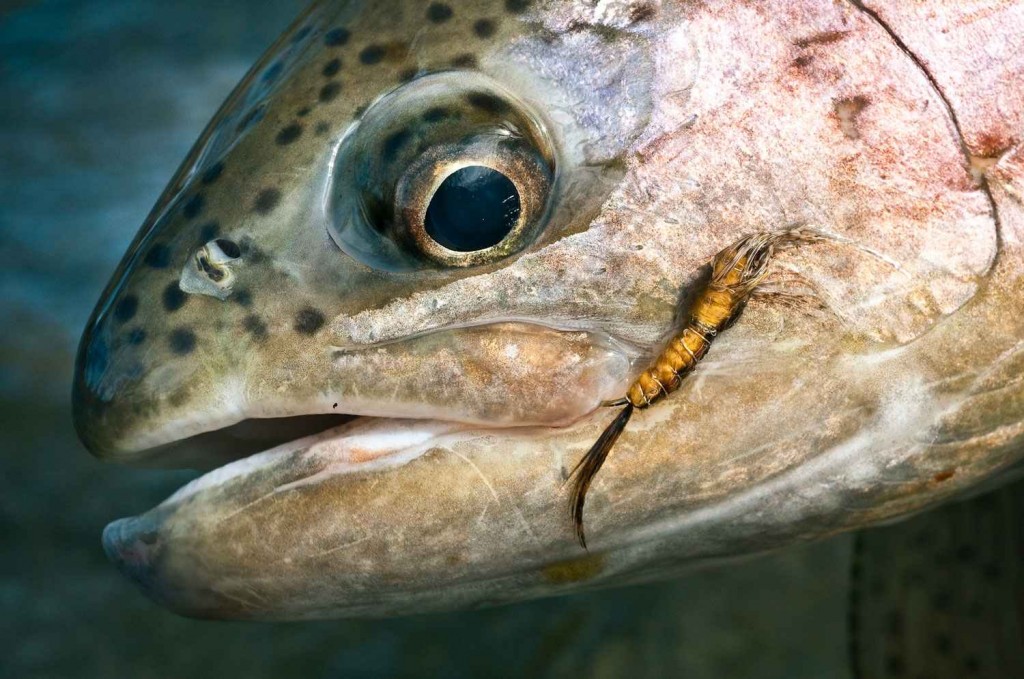
Realistic movement in fly patterns is just as important as having a realistic look. Photo By: Louis Cahill
Worthless may be a little overboard, but there is some truth behind it.
Every year new fly tying products burst onto the scene that are specifically designed for making our fly patterns look extra realistic. I’ll be the first to admit many of them are amazingly cool and innovative. I mean, who wouldn’t want black eyes on their tungsten beads, or a perfect set of pre-molded wing pads or stonefly legs you can plop on a hook to make your nymphs look ultra life-like, right? Seeing these new innovative materials for the first time always gets me giddy, like a fat guy spotting a 5 for 5 deal at Arby’s. But here’s the real question I think we should be asking ourselves. When it comes to purchasing and tying our fly patterns, should we only be focused on how realistic they look?
I say hell no, but you’d be surprised how many fly fishermen out there believe “a realistic look” trumps all other attributes in a fly. Ask a fly shop owner why they carry them if they don’t catch fish, and they’ll quickly tell you, because they sell like hot cakes, that’s why. I think a fly being realistic is great, but there needs to be more working elements in a pattern than just a flashy realistic look. I’ve personally found, that a lot of the time the more realistic you go with fly patterns, the more unrealistic they end up moving and looking in the water. And if they don’t look good in the water, chances are, they’re probably going to be worthless for catching fish. For me, the key to tying and picking out successful fly patterns from the bins over the years has been to always make sure a pattern incorporates equal parts of realistic features and movement. When you can find both in a fly pattern, you’ve got something special.
If you want to get the most out of these new realistic tying materials on the market today, I suggest you compliment them by pairing them up with natural tying materials that have lots of movement in the water. Doing so, you’re flies will both look and move super realistic, and I guarantee you that most fish will find that combination irresistible.
What’s your thoughts?
Keep it Reel,
Kent Klewein Gink & Gasoline www.ginkandgasoline.com hookups@ginkandgasoline.com Sign Up For Our Weekly Newsletter!
You need no more proof of this thesis than the Wooley Bugger. If I could put Marabou in every pattern I would. Movement rules.
Steve,
Good to hear from you. Marabou has got to be one of the most versatile and best tying materials for movement. I feel the same way.
Kent
I agree. A buddy of mine has been tying some crayfish with new foam product, they look just like the ones we caught as kids, however the only movement will be what the line and current creates. I often think of buying some of the new tying materials but my stock of material is great enough now and has been proven over time. I will stick with Marabou.
Trap,
I want to make it clear to everybody that I love all these new super realistic tying materials. My suggestion is for fly tiers to not forget about the movement side of their fly patterns. That they should take advantage of these new materials, but also do their best to incorporate other tying materials in the pattern that breath and move well in the water. Doing so, the finished pattern will rock to the fullest.
Kent
I like the pattern in the bows jaw. Wanna give up the pattern?…or at least the name. Looks a bit like a Tellico only w forward facing soft hackle…for “movement I suspect.
Ben,
This is one of Louis’s stonefly patterns. As far as I remember the soft-hackle wasn’t tied forward, it was just premium partridge hackle which gives it that great range of movement and motion. I’m sure Louis will be glad to give you a quick recipe list if you email him. He might even post it on here when he see’s your comment.
Kent
A soft hackle collar on a nymph, really seems to make if produce better than a nymph without. I don’t know if it looks like gills or legs or what, but there seems to be something about it.
Greg,
I always try to incorporate soft-hackle in all my nymph patterns. It’s buggy look and ability to breath and move in the water makes it a killer fly tying material.
Kent
Love me some Hun. Can’t live without it. Can’t pass up a good skin when I find ’em.
Thanks for the reply and I will be looking for that stone pattern soon.
Pingback: Tippets: Fishing Presidents, Carbon in the Food Chain, Reduce Water Usage, Realism vs. Movement in Fly Patterns | MidCurrent
Hey Kent always a good Monday read for me, just one thing, maybe I’m just old, but sure wish you could make the print in the main post a little more bold, it be some easier on the peepers. I’ll be here either way though!!
Wayne,
Our new website version coming this month will have text that’s easier to read.
Kent
Said like Homer Simpson thinking of beer, “Soft hackles MMMmmm…”
My only comment will be in the form of a (slightly fuzzy) picture, and to note that these catch fish (bass ‘n’ pike anyway) like crazy:
[IMG]http://i189.photobucket.com/albums/z239/groznak/2c69dffb.jpg[/IMG]
Always look forward to getting hookedup, G&G style.
Will using a loop knot versus a clinch knot aid in movement?
Allen,
Yes a loop style knot can add a little bit more movement. I usually do not use them though.
Kent
Morning Kent:First time poster….picked up G&G from the croniclesofcod blog.Glad I did.Enjoy your stuff big time plus it lets me know its Monday when I open my email.Realistic bugs worked wonders in a tougher than normal fishin’season this summer …also i agree with Allen aloop knot greatly aids in the flys movement….keep up the good work and great photos…nick
Nick,
Welcome my friend. Glad you’ve been enjoying the blog. Where’s your home water? Thanks for your feedback on this subject.
Kent
Home water best kept as a secret, but its in Alberta Canada and runs thru the city of Calgary…hahaha
Nick,
Right on man. Glad to have you here and i’m jealous of you. What a fine fishery that is.
Kent
Hi, I think movement is way more important! Alot of the time I think fish “hit” or “take” a fly due to a reaction strike!
Trout Bum,
Thanks for casting your vote on what you think is more important in fly design. If we eliminate midges and dry flies I especially think movement is more important.
Kent
While I agree that impressionistic patterns with some movement are often better, you can’t overloop the success of patterns like the Copper John. It has the size, shape, and color–and it sinks quickly into the strike zone, something that flies that are bulked up with lots of hackle often do not do. This is especially important in faster water where softer materials don’t often show off their movement quality.
Great discussion.
Troy
Fishing lures in general are made to catch fishermen.
Wayne,
Its often that way with fly patterns as well, isn’t it. Thanks for the comment.
Kent
First- its not just fat guys who can appreciate a 5 for 5 at Arbys… There are days on the river where I would likely trade and piece of terminal tackle for 3 of those 5 handsome roast beef sandwiches…
But for movement, I do not think the importance can be overstated. I see a lot of new saltwater flies moving towards the “ultra- realistic” and they have everything but that “trigger” just before then moment when the fish attacks bc he sees a flick of the tail or a wiggle of the body. Trout flies are no different if not just a bit less noticeable. Fish have more instinct than intellect and just like when a chick walks by with that little wiggle or switch… its damn hard to refuse.
No no!
I want everyone to use them realistic flies!
That way I can catch all the fish using my buggy looking nymphs… 🙂
For saltwater. Why do spoonflies work so well? The most productive flies have always been a caricature representation of the prey. Whatever is stimulating the target species to attack should be exaggerated in your fly and mass, motion and movement should not distract. Sometimes color may be the most important characteristic. Sometimes all the Redfish want is pink or if the Little Tunny are feeding on “red minnows”, you gotta have red in the pattern. After 70 years of flyfishing I believe the more realistic the pattern the less likely of your success.